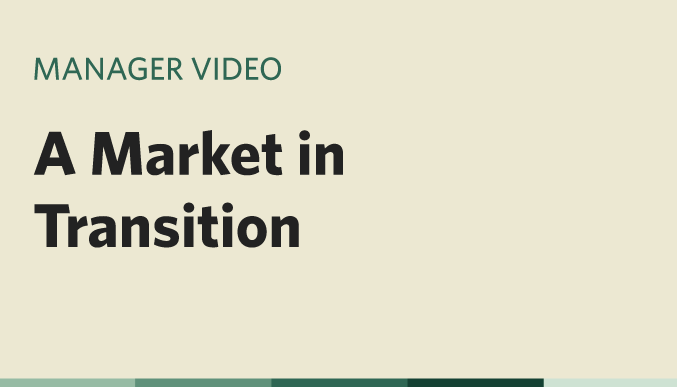The end of the easy-money era, why fundamentals matter again and drivers of recent performance
Transcript
| Speaker | Timestamp | Statement |
|---|---|---|
| Chris Davis: | As you look back over the last almost 15 years, it is only just now beginning to seep into consciousness just how extreme the distortions of this environment were. And they weren't extreme in the sense of normal financial cycles. They were extreme in a historical sense. You had the cost of money reduced almost to zero. At the same time, an enormous amount was being printed. This was a massive distortion of the entire pricing mechanism, and it's affected the economy, it's infected markets, it infected investors like us, and it's only now beginning to unwind. Now, let me explain what I mean by that. What I mean by that is that over all of human history, it makes sense that if you have a productive asset and you let somebody else use it, they have to pay you for that, right? The payment for that is what we call interest. | |
| So I lend my money to somebody else to use. I don't get to use it, so they pay me for that. Well, when all of that concept of interest sits at the bedrock of investing, and it certainly sits at the cornerstone of our investment discipline, we look at businesses, we project out what we think those businesses will earn. We think about different environments. We think about recessions and booms and busts. We look at competitive dynamics, and then we discount those earnings back to the present. Earnings today are worth more than earnings in the future because the earnings in the future are less certain. Well, if interest rates are free, none of that matters. Hoped for earnings in the distant future are worth the same amount today as earnings today, that bird in the hand ends up being worth less than the two in the bush out in some hoped for future. | ||
| So this was a period of time in which we focused on building wealth for shareholders. We focused on the quality of the companies we own, their durability, their resilience, their balance sheet strength, and our companies did make progress and we built wealth for shareholders. And yet we were so out of sync with the market that it looked in some ways, like what we were doing wasn't working. The market galloped ahead and although we built wealth, we did it at a slower rate. Because the very characteristics that we prize were not relevant in a world where everything was about stories and free money and new eras and new monetary theories and the new thing and a sense that all of the old world rules no longer apply. Well, all that changed in March of 2022, right? We've had 11 interest rate increases since then, and all of a sudden people are beginning to see the foolishness that was happening then. | ||
| And that is too short a time to extrapolate, but to me it's encouraging that we've outperformed since then, right? We've built wealth since then, but we've also built wealth at a greater relative basis. And we've had plenty of shocks and strains in the system, and it's too short a period to extrapolate. But what we are seeing is that the very qualities that we value, the durability, the relative balance sheet strength, the competitive position, the nearness of earnings, dividends, old-fashioned durability matter again, and we see people losing faith in sort of the hopes and dreams. So you've started to see that happen in things like the regional banking crisis, right? It was amazing to look at the interest rate risk that companies like Silicon Valley Bank and First Republic took. I mean, we own a lot of banks, and I'll make a case for why banks are particularly well-suited in this environment. | ||
| But those were companies that were taking crazy risks, as if somehow free money was going to last forever. Well, it was incredibly irresponsible. We saw some UK pension funds that have begun to crack. We've seen the government bond, the area where people feel the safest. The 30-year government bond down 50 or 60%, the 10-year bond down 30%. These are the areas where people thought they weren't taking risk, and we would say you're taking enormous risk, right? And so as the system begins to adjust, I think our view is we're in the early innings. This was one of the biggest bubbles in economic and market history. And as it normalizes, investors who aren't prepared, investors who think we're going back to this crazy new world of free money and low inflation despite huge spending, unending deficit spending, companies where earnings don't matter, where it's all about eyeballs, you can always raise more capital. | ||
| We're not going back. And so what we think is the opposite, we're going back to the original fundamentals. What really matters? The basic tenants of an investment discipline that's based on money having a cost discounted present value, expense control, capital discipline, balance sheet strength, durability. These are the pillars of our investment discipline. And we think in a sense, the world is coming our way. There is going to be a lot of disruption and dislocation in this period. You better be prepared. You better be able to adapt. So we're not blowing the all clear of smooth sailing and one way markets, but we think exactly the characteristics that we look for are just now coming back into favor. They really have been the bedrocks of a philosophy that's played out over five or six decades, but we were in a period that was so anomalous that people forgot that of course, money has a value. | ||
| Of course, time matters. Of course, earnings matter. Of course, discipline matters. And so we feel the world is moving our way. We feel we've got relative ground to makeup, we're moving in the right direction. And in a way, we feel this is a return to normalcy. It's the end of a period of distortion. As we look at this period, this return to normalcy, we can look at two categories. One, what is out of favor and isn't going to come back. And you think about the story stocks, the hypes, the dreams, the capital consumers, the companies that relied on free leverage, that's gone. Well, where do you want to be positioned on the other side? And this is where we've built our portfolio with a few major themes. And the most important one is around durability. And the durability can be about how the company itself is structured, but also about the business model. | ||
| We want companies that can go through a recession, can go through a downturn. Second, we want resilient growth. We want companies that are going to be worth more 5, 10, 15, 20 years from now. So we want resilient growth and we want durability. So let's look at some categories of how that shapes out. Well, I'm going to start with the most controversial one, which is banking, right? Because people think, oh, we went through a financial crisis. We just had First Republic and Silicon Valley Bank, how can you be in banks? And the answer is because banking is a durable business model, and the banks we own have the least risk that we have seen in our entire career investing in banks, they have the highest capital ratios, they have the lowest credit risk. The banks that we own have taken low interest rate risk. They have enormous resiliency, enormous durability. | ||
| FinTech has sort of imploded, so they have a great competitive position. We think the re-regulation is at the end of that period, and yet they're at the biggest discount that they've ever traded at relative to the market averages. So think of banking as one big theme where the perception is different than the reality. Well, the second theme that we love is what we call durable resilient growth. And so these are companies that aren't the high-flying rocket ships that are flaring out where all of the value was in the far distant future. These are companies that generate enormous cash, have enormous value to their customers, and are very difficult to obsolete. So certainly think about companies like Google, think about companies like Meta and Amazon, but also what we think of as the picks and shovels company of this enormous technology revolution. Whether it's AI, there are all these AI hype stocks, but all of those devices that will run these technologies, run on Silicon. | ||
| And that Silicon is made by companies like Applied Materials, the central holding of ours in semiconductor capital equipment. Third, we think about this inevitable inexorable increase in healthcare spending, healthcare inflation. And so people look at, ah, well, hot new drugs, ozempic, new biotech waves. All of those things are powerful waves, but they are very unpredictable. They're very expensive. We like companies that operate in the system in a durable way, that are part of a solution rather than a problem. | ||
| Think about the lab testing companies like Quest, and also think about the health insurers that are providing value to their customers by helping manage their cost inflation. The final theme that I'm going to touch on is just to recognize that it's a big world out there and that we have been in a period where the US has been so dominant in terms of our market performance versus the rest of the world. We want it reserve in our mind the opportunity to own companies that are as good or better that are global. But because they happen to be listed outside of the US, they trade traded a big discount. So we're going to keep a space in our portfolio for best in breed companies that happen to be headquartered somewhere else. |
Related Videos
The Most Important Things We Believe Equity Investors Should Focus on Today (6:18)
Why we believe selectivity is more important in a time of great market and economic transition and highs in both market concentration and valuations
Rigorous Research & Selectivity are Critical in Today’s Market (2:14)
Why we’re focused intently on identifying resilient companies with above average growth prospects - and not overpaying
Share this Video
Click here for current fund holdings: DNYVF


